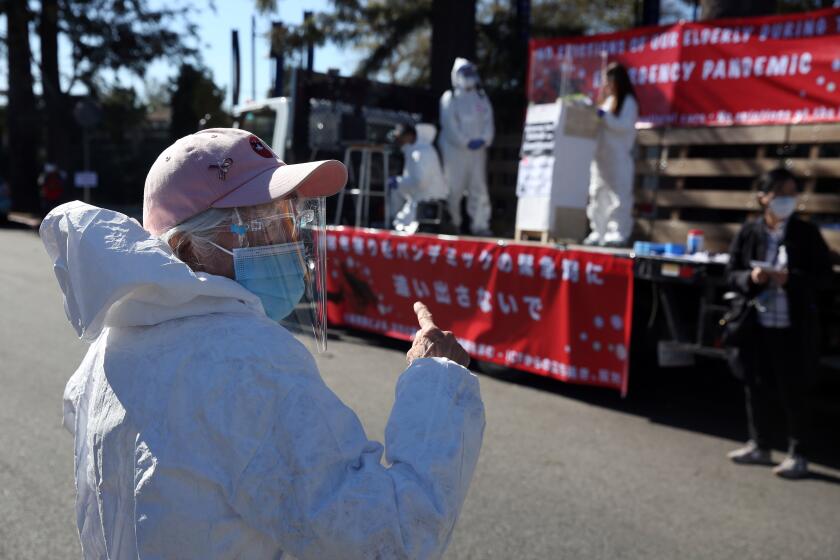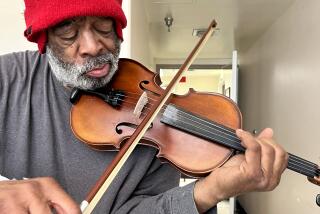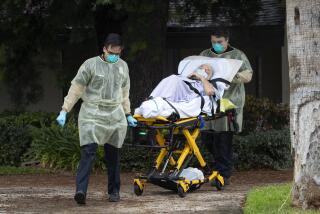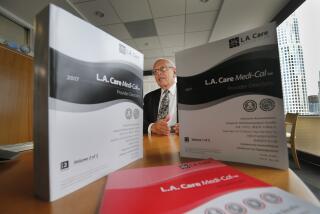Column: How did a home built for Japanese American seniors become the state’s deadliest nursing facility?
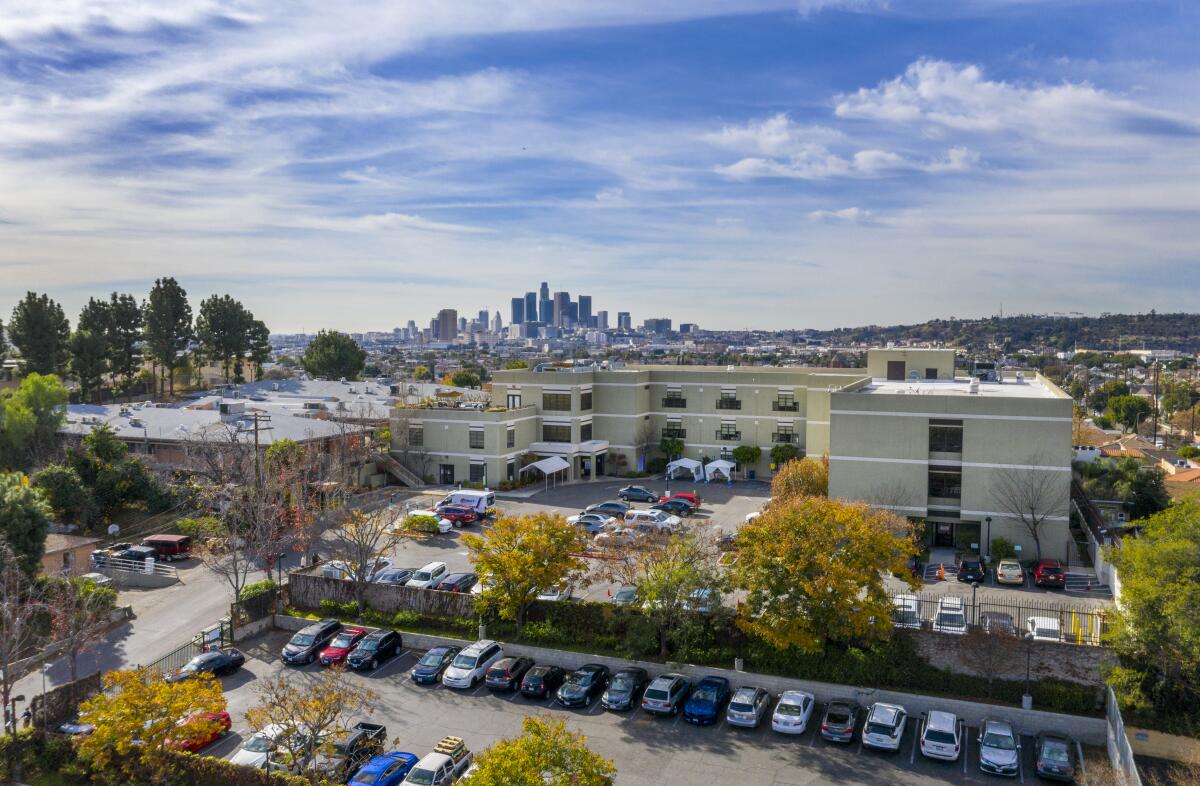
- Share via
Tracy and her family agonized over moving her grandmother from the nursing facility in Boyle Heights where she had lived comfortably for four years, especially in the middle of a pandemic.
But her grandma had suffered some bad falls and needed the extra care. Wait lists at Kei-Ai Los Angeles Healthcare Center, a Lincoln Heights skilled nursing facility that was originally designed around the cultural needs of the Japanese American community, could get long. A staffer assured them that the facility was COVID-free and emphasized that a vacant bed would not last.
So they packed her some new toothbrushes, her favorite pink floral print pajamas, a few treasured family photos and everything else they could think of. They squeezed out tearful goodbyes and promised to bring her home before her 106th birthday a few weeks later, on Jan. 2.
But days later, an outbreak of COVID-19 was announced. Weekly texts tallying the coronavirus’ precise advance through the center began to arrive, and every week the numbers doubled.
In the month of December, 31 COVID deaths were reported at Kei-Ai Los Angeles. Among them was Tracy’s grandmother.
“It breaks our hearts because we don’t know what her last weeks were like,” Tracy said. “We didn’t know this was going on. We were told they were COVID-free and we could visit twice a week.”
Kei-Ai Los Angeles was one of 27 nursing homes participating in a little-publicized county program that allows nursing facilities to volunteer to receive COVID patients from hospitals and other nursing facilities. At least 97 COVID deaths overall have been recorded at the center, making it the most deadly nursing home in the state, according to data compiled by The Times.
Because contact tracing data are unavailable, it’s impossible to know what exactly caused the outbreaks. But the nursing homes are used to back up overtaxed hospitals, and as ICU bed availability in Southern California hit zero in December, deadly outbreaks occurred at several designated centers.
Three of the four most lethal outbreaks at nursing homes in the state were at these county-designated facilities — 61 have died at Rinaldi Convalescent Hospital and 57 have died at Grand Park Convalescent. The county-designated nursing homes represent 8% of skilled nursing capacity in the county but account for 18% of all deaths, according to a Times analysis.
Relieving overtaxed hospitals and their exhausted staff is essential. But this policy has allowed for-profit companies that run many nursing homes to volunteer their residents for the increased viral risk — and profit — that the transfers represent.
Patients and doctors say they were never informed or consulted about Kei-Ai’s participation in the program. And many now are questioning the wisdom of a policy that relieved hospital crowding by placing the most vulnerable people at risk. Nearly a third of all COVID-19 deaths have occurred at nursing homes.
Dr. Takeshi Matsumoto began 2020 with 15 patients at Kei-Ai Los Angeles. Most of them have contracted COVID-19, and five have died.
“Why would you volunteer to be a COVID-designated facility knowing that you’re going to be endangering the current residents there? I don’t get that at all,” Matsumoto said.
::
This wasn’t always the plan, health officials say. At first, the county restricted hospital transfers of COVID-19 patients to nursing homes to protect elderly patients.
But hospitals needed to free up space for anticipated surges in infections and asked county officials for help. In April, officials decided to prepare a group of skilled nursing facilities to back up hospitals.
Eligible facilities had to be COVID-free, with two years of clean inspection records. They submitted to quarterly inspections. County experts reviewed and approved the nursing facilities’ COVID procedures first on paper, then by videoconference.
Facilities were required to notify staff and patients of the new designation before they could be listed on the county’s website. But county health officials declined to say whether they attempted to verify that nursing facilities did so.
Matsumoto, who has seen thousands of patients at Kei-Ai Los Angeles over the years, said none of his 15 patients or their families were aware. Other doctors and patients’ families that I spoke to also said they were unaware.
“They should have informed the families so they could take precautions and give them an option to move out. I feel responsible too,” Matsumoto said.
Tracy Imamura sits on a community advisory board that was established to help the facilities serve the needs of the Japanese American community. But the facility never notified the community advisory board that it was seeking this status, Imamura said. The board would have recommended against that, she said.
Tanner Mitchell, the administrator of Kei-Ai Los Angeles, declined to answer questions about disease protocols, the county program and whether the facility had done enough to notify residents and staff.
He says Kei-Ai partnered with city and county officials to become one of the first facilities to test all patients and staff on a weekly basis. Kei-Ai has three floors, and one was designated as a COVID ward, which he said allowed the facility to obtain priority access to county and state public health resources. He declined to say what those resources were.
“We will continue to honor the legacy of these communities, these patients, and these families. We are all in this together,” Mitchell wrote in a statement.
County health officials declined to reveal the number of transfers to each designated nursing facility, which would have allowed a better understanding about the connection between transfers, infections and deaths.
But local hospitals transferred at least 71 patients to Kei-Ai Los Angeles in December, according to a doctor with knowledge of the matter.
Dr. Zachary Rubin, who leads the county’s infection control efforts, acknowledged the outbreaks at nursing facilities in an email to a Kei-Ai Los Angeles community advisory board member that was shared with me.
County health officials had been working closely with Kei-Ai Los Angeles since early in the pandemic, and it was “unclear” why outbreaks were happening now, Rubin wrote.
“These outbreaks are occurring despite extensive work by LAC DPH [Los Angeles County Department of Public Health], CDPH [California Department of Public Health] and facilities to upgrade infection control, institute twice weekly testing of all staff, and with residents and SNFs [skilled nursing facilities] being more experienced with the CDPH-established quarantine schemes,” Rubin wrote.
Matsumoto acknowledges that federal disease protocols have changed multiple times and that the early difficulty in obtaining tests made isolating patients difficult. But he alleged that protocols at Kei-Ai weren’t always followed. He said he’s aware of COVID-positive patients at Kei-Ai who were returned to healthy floors without being tested.
“I understand they were going to quarantine the patients, but you know something? It’s very difficult to do that. It’s pretty obvious they failed,” Matsumoto said.
Each of the 27 facilities that volunteered to receive COVID patients is run by a for-profit company. Under a Medicare rule change last year, skilled nursing facilities stand to double or even triple the amount of daily revenue they would get by taking COVID patients.
Some in the Japanese American community say that Kei-Ai Los Angeles’ troubles began long before the pandemic, when the facility and its sister facilities in Torrance and Boyle Heights passed into private ownership.
Keiro Senior Healthcare was founded by community leaders in the 1970s to establish culturally sensitive places for Japanese American seniors to grow old. With donations from the community, it established nursing homes that celebrated Japanese holidays, catered to Japanese diets and allowed seniors to look forward to growing old among friends. Generations of young Japanese Americans have volunteered at these centers and found valuable connections to their history.
In 2015, citing rising costs and the lack of demand for Japanese-language healthcare in later generations, Keiro sold the facilities to Pacifica Senior Living, a San Diego company that runs more than 80 facilities across the country.
The sale was fiercely opposed by many in the community, who formed a nonprofit advocacy group called Koreisha Senior Care and Advocacy and called upon then-Atty. Gen. Kamala Harris to intervene.
The sale was approved in 2016, but Harris’ office required Pacifica and its contracted operator, Aspen Skilled Healthcare, to meet certain standards for care and cultural sensitivity for at least five years.
The conditions also called for the creation of a community advisory board to represent patients, kept rent level for current residents and stipulated that the funds from the sale of the facilities must be spent on care for Japanese American seniors.
But residents, patients and doctors say conditions have steadily declined. Nurse pay was cut, and bilingual nurses with decades of experience quit. The cultural programming that had attracted so many Japanese American seniors was largely eliminated. Familiar Japanese meals of tonkatsu and natto were replaced by vaguely Asian noodle soup and rice.
The future of 64 senior residents of the Sakura Gardens intermediate healthcare facility, mostly Japanese Americans in their 80s and 90s, is in jeopardy.
The sale conditions expired last week. And last year, Pacifica submitted plans to redevelop the Sakura Immediate Care Facility in Boyle Heights into an apartment complex. Pacifica says it has no plans to immediately demolish the facility and is exploring other options for the property. But if the facility is demolished, many of the Japanese American seniors fear they will be transferred to Kei-Ai Los Angeles.
The seniors at these facilities are among the oldest and most respected members of the Japanese American community. Their birthdays are often celebrated with announcements in the Rafu Shimpo, an L.A. newspaper covering the Japanese American community. But lately the newspaper’s pages have more often featured their obituaries.
Tracy’s grandmother came to America after working as a switchboard operator on a U.S. naval base in Hawaii. She started a family in Boyle Heights and was imprisoned at the Tule Lake incarceration camp during World War II.
She couldn’t speak much English and lived most of her life in Little Tokyo. But there, she found work in local businesses and friends to play mahjong and hanafuda cards with. She became a huge fan of the Dodgers and was the proud owner of a signed Hideo Nomo ball that she loved to show off, Tracy said.
And she loved snow, Tracy said. For her 106th birthday, they had planned to rent a snow machine to turn their backyard into a wintry surprise party.
Instead, she and her family spent the last month going through their grandma’s belongings to catalog all the items the nursing facility misplaced. The possessions, collected in suitcases and trash bags, tell a painful story about her grandma’s last week.
Her grandma’s dentures were still caked with food, and the brand-new toothbrushes they had packed for her were unopened. Some of her grandmother’s clothes were damp and soiled. Others, stained with bleach and torn. The family photos were missing, as was a thousand-dollar hearing aid and a brand-new bathrobe.
In one of the trash bags, Tracy discovered the laminated note that they had written to the center’s staff and packed into one of her suitcases. Someone had returned it.
“This is our grandmother. We love her very much and are sad to see her go,” the note reads. “She is 105 years old and can sometimes be forgetful. She may be shy or quiet because she is in a new environment. Our biggest fear is that she would feel scared or alone.
“Please show her as much patience and kindness as possible. We truly appreciate the care you will be giving her.
“Much thanks from her grandchildren, great-grandchildren and great-great-grandchildren <3”
Times staff writer Ryan Menezes contributed to this report.
More to Read
Sign up for Essential California
The most important California stories and recommendations in your inbox every morning.
You may occasionally receive promotional content from the Los Angeles Times.
